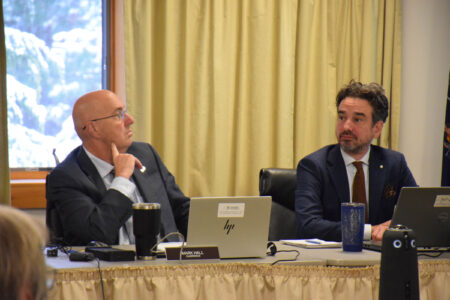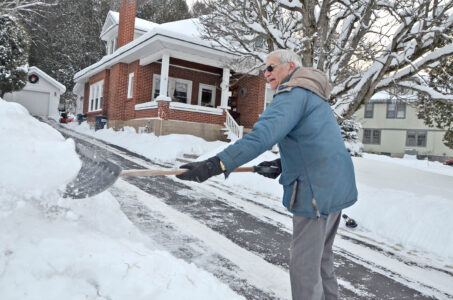Korean martial art flourishes in Saranac Lake
- Adult students practice strikes at Northeast Taekwondo in Saranac Lake. Pictured from left, are Tim Fink, Tisha Siddell, and Lori Moore. (Enterprise photo — Glynis Hart)
- Grandmaster Jon O’Kelly and Mason, a blue belt, demonstrate a pattern for the class. (Enterprise photo — Glynis Hart)
- Youngsters learn self-control and confidence along with listening skills at Northeast Taekwondo in Saranac Lake. (Enterprise photo — Glynis Hart)
- Danielle King smashes a board held by Grandmaster Jon O’Kelly at Northeast Taekwondo in Saranac Lake. (Enterprise photo — Glynis Hart)
- Linda Moore, right, shatters a board held by Lori Keough at Northeast Taekwondo. (Enterprise photo — Glynis Hart)
- Lori Keough, left, holds a board for Linda Moore to break at Northeast Taekwondo. (Enterprise photo — Glynis Hart)
- Lori Keough breaks a board with her foot. (Enterprise photo — Glynis Hart)

Adult students practice strikes at Northeast Taekwondo in Saranac Lake. Pictured from left, are Tim Fink, Tisha Siddell, and Lori Moore. (Enterprise photo — Glynis Hart)
SARANAC LAKE — When Jon O’Kelly and his wife Lidia opened Northeast Taekwondo in Saranac Lake two years ago, they did the construction work on the studio themselves. It took a few months to lay the wooden floors, paint the walls, prepare changing rooms and a handicap-access bathroom, and a few curious onlookers kept an eye on their progress.
One elderly lady, who had been watching the goings-on, asked O’Kelly what he was building.
“A Taekwondo studio,” he said.
She said, “As long as it’s not a bar.”
The memory makes O’Kelly laugh. “The community here has embraced us so much. When we first started, people weren’t sure what what we do. What is Taekwondo? A lot of people had never heard of it.”

Grandmaster Jon O’Kelly and Mason, a blue belt, demonstrate a pattern for the class. (Enterprise photo — Glynis Hart)
Eighteen months after the first classes started, almost every class is full. There are classes for kids, teenagers and adults; every class has two sessions a week.
The O’Kellys came to Saranac Lake almost by accident. They had a dojang, or school, in Washington, D.C. and they wanted to get out of the city, but they didn’t have a clear idea of where they wanted to go. Lidia’s sister gave them a free stay at Mirror Lake Inn in Lake Placid, and when they looked around the area, they liked it.
In the end they found the perfect house in Saranac Lake. “I love it,” said O’Kelly. “It’s a mile from door to door — house to work. And in the summer I can ride my bike!”
Although karate and kung fu, the martial arts of Japan and China, may be more familiar to people in the United States, there are so many schools and disciplines, with competing rules and styles of combat, that competition tends to be splintered along those lines as well. Taekwondo, the official sport of South Korea, originated on the Korean peninsula.
“The tradition was, father teaches son, son makes changes, son teaches son, son makes changes,” said O’Kelly. “With kung fu and karate, it’s like a tree that produced many branches.”

Youngsters learn self-control and confidence along with listening skills at Northeast Taekwondo in Saranac Lake. (Enterprise photo — Glynis Hart)
Taekwondo appeared to be going that way until 1955, when leaders of the various kwans, or schools, decided to work toward unifying the sport. General Jong Hi Choi, considered the father of Taekwondo, brought them all together under one name and founded the Korean Taekwondo Association.
“He brought the branches back to the trunk,” said O’Kelly. “It was a genius move.”
Genius because the International Olympic Committee recognized the sport in 1988 and made it a medal sport eight years later. “As soon as the IOC recognized us, taekwondo flourished,” said O’Kelly. By 1988 O’Kelly had already had his own dojang for three years.
Now, he said, “Taekwondo is the largest single most practiced martial art in the world.”
Although there are different forms, everyone starts with the basics. Breathing, kicking and blocking and taekwondo philosophy are foundational. Students at Northeast Taekwondo recite five principles at every class: Courtesy, Integrity, Perseverance, Self-Control, and Indomitable Spirit.

Danielle King smashes a board held by Grandmaster Jon O’Kelly at Northeast Taekwondo in Saranac Lake. (Enterprise photo — Glynis Hart)
Parents of kids taking classes say it helps them in life.
“Their behavior has to be as good outside as it is here,” said Linda Moore. Moore has a seven-year-old taking classes, and attends the adult classes herself twice a week. When it’s time for students to move up in rank and get the next belt, “Grandmaster O’Kelly requires a note from their teacher, so he knows they’re applying the principles in school, as well.”
Students begin with basic skills: stepping, punching, kicking, blocking, and then learn to do these in patterns. Each level requires certain skills and the proper execution of the patterns.
“It isn’t just keeping in shape,” said Moore. “It’s a discipline. Part of it is getting to learn a new language, a new culture.”
There are also psychological and emotional benefits. Tim Fink and his son Noah, age 9, started at the same time. “It’s something we can share. Noah and I are the same belt,” said Fink. For him, it’s a break from the work day and a chance to focus on himself.

Linda Moore, right, shatters a board held by Lori Keough at Northeast Taekwondo. (Enterprise photo — Glynis Hart)
Kids and adults gain in confidence, and not just because they’re learning self-defense. “The board breaking is an incredible experience for the kids,” said Moore. “And I was surprised to learn that being able to yell is relaxing.”
When taekwondo students deliver a strike, they learn to expel air from their lungs with a shout or sudden exhalation. This has the dual benefit of increasing the force of the strike and softening the body, so that if the opponent lands a hit there’s less resistance.
Lori Keough, who started taking taekwondo last November after watching her son do it for two months, said, “Never in my life have I had any sort of exercise where I looked forward to going to it. I love all of it. I get grumpy when I can’t go to class.”
Danielle King and Harold Blanchard travel together from Lake Clear to take the adult classes.
“I’ve always wanted to do this,” said Blanchard. “Since I was a kid. It was always too far away.”

Lori Keough, left, holds a board for Linda Moore to break at Northeast Taekwondo. (Enterprise photo — Glynis Hart)
King counts the benefits of empowerment, self-defense, and exercise, as well as “challenging my brain.” Learning the patterns requires a lot of discipline and focus.
Taekwondo offers women a chance to excel, said O’Kelly. “Women are built for taekwondo. Men, we have tighter hip sockets, tighter musculature in the upper thighs and hips. We have to work harder for the same gains.”
Taekwondo, with its focus on high kicks and leg work, favors women’s lower center of gravity and more open pelvic girdle. Meanwhile, O’Kelly emphasizes that it’s something anyone can do, no matter their age or [lack of] experience.
“In Albany, a girl came to me who was deaf, who wanted to learn taekwondo. So that was a challenge for me as a teacher: How are you going to teach if you can’t communicate? I traded her mother taekwondo in exchange for sign language,” said O’Kelly. Then, after he began using sign language in class, other deaf students followed, and finally he began teaching all of his students to sign the words they needed in class.
“We became known as the deaf dojang,” he said with a smile. “So that’s a good story.”

Lori Keough breaks a board with her foot. (Enterprise photo — Glynis Hart)











